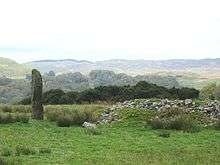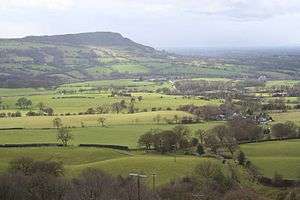Double sunset
A double sunset is a rare astro-geographical phenomenon, in which the sun appears to set twice in the same evening from a specific viewing-point. Such phenomena may have been regarded as significant in prehistoric times, and double sunsets have been discussed in the context of archaeoastronomy by researchers such as Alexander Thom.[1]
Spain
In the town of Güímar in Tenerife a double sunset has been observed in alignment with the local pyramids at summer solstice.[2] In Spanish the phenomenon is described as a doble puesta.
United Kingdom
England
Staffordshire
A well-documented example of a double or occulted sunset is associated with Leek, Staffordshire, England. The phenomenon is viewable from the town on and around the summer solstice in good weather.[3][4][5]
The first published mention of the Leek double sunset was made in 1686 by Dr Robert Plot in his book The Natural History Of Stafford-Shire.[6] The phenomenon would have been visible well before the seventeenth century. However, the alignment of sun and landscape is subject to change over the centuries as it is affected by the Earth's axial precession. This was realised by Plot who suggested that the sunset could be used to measure the obliquity of the ecliptic.[7] (see note1)
The traditional location for observing the phenomenon, as described by Plot, is the churchyard belonging to the parish church of St Edward the Confessor. The church is a medieval building, and it has been conjectured that the churchyard is an example of an ancient sacred site having been Christianised. Because of the chronology of the changing alignment, it seems that the site could not have been a viewing-point for the double sunset before the Iron Age. The first people to view the phenomenon may have been the area's Iron Age inhabitants.[7] It has been argued by Jeff Kent that the first people to witness the spectacle may have been Danish settlers from the Great Heathen Army, which invaded England in the ninth century.[8]
From a particular point in the churchyard, the whole of the sun set on the summit of Bosley Cloud, a millstone grit hill six miles to the northwest. The sun partially reappeared from The Cloud's steep northern slope and soon afterwards set for a second and final time on the horizon.[9] The spectacle was last reliably witnessed, and filmed, from the churchyard in 1977,[10][11] but is no longer visible from the location because of tree interference.[12][13] It is, however, still observable from Leek on and around the summer solstice from the road to Pickwood Hall, off Milltown Way,[14] and from Lowe Hill on the outskirts of the town.[15] Better viewing points, though, are from the A 523, above Rudyard Lake,[16] and Woodhouse Green,[17] both of which are nearer to The Cloud and therefore enable a larger proportion of the sun to reappear.
Derbyshire
Further double sunsets were identified by Jeff Kent in 1997 from three places in west Derbyshire, observed against Chrome Hill, Parkhouse Hill and Thorpe Cloud (three limestone reef knolls):[18]
- Chrome Hill. Observed from Glutton Bridge for a short period around the summer solstice. The sun sets just to the southwest of the summit of the hill, begins to re-emerge almost immediately afterwards from its steep northeastern slope before fully reappearing and later sets for a second and final time at the foot of the hill.[19]
- Parkhouse Hill. Visible from nearby Glutton Grange in late March, early April and September. The sun sets just to the south of the summit of the hill, begins to re-emerge almost immediately afterwards from its steep northern slope before fully reappearing and later sets for a second and final time at the foot of the hill.[20]
- Thorpe Cloud. Viewed from the top of nearby Lin Dale on and around the summer solstice and perhaps beyond. The sun sets on the summit of the hill, partially reappears from its steep northern slope and sets for a second and final time shortly afterwards.[21][22]
Scotland
In the 1950s Alexander Thom surveyed a megalithic site at Kintraw, a locality on the mainland of Scotland, in the context of a double sunset on the island of Jura (both the island and the mainland site are in Argyll and Bute).[1] The proposed alignment is to a notch at a distance of 28 miles between the mountains of Beinn Shiantaidh and Beinn a' Chaolais which are visible from Kintraw.[23]

Thom described the site as a type of midwinter observatory, but his interpretation has been the subject of controversy, one point at issue being the visibility of the midwinter notch: a higher observation point is needed to see the midwinter notch on Jura over a nearby ridge. Euan MacKie, recognising that Thom's theories needed to be tested, excavated at the site in 1970 and 1971, and found evidence for an observation platform.[24]
Notes and references
Notes
- 1.^ A shortened version of Kilburn's article can be accessed at Dr. Plot and the Amazing Double Sunset.
References
- Thom, A (1954) “The solar observatories of Megalithic man.” Journ. Brit. Astron. Assoc. 64, pp. 397-00.
- "Summer solstice at the Piramides de Güímar". Island Connections.
- Kent 2001, pp. 1, 3, 4.
- Staffordshire Tales of Mystery & Murder, pages 26 and 28–30, David Bell, Countryside Books, 2005.
- Machin, Byron (2004). The Prehistory of the Peak District (Media notes).
- The Natural History Of Stafford-shire, pages 2–3, Robert Plot LL.D., Oxford The Theatre, 1686.
- Kilburn, Kevin J. (1999), "Dr Plot and the amazing double sunset", Astronomy & Geophysics, 40 (1): 1.20–1.22, doi:10.1093/astrog/40.1.1.20
- Kent 2001, pp. 29-32.
- Kent 2001, pp. 3–4.
- Evening Sentinel, 22 June 1977, page 11.
- Kent 2001, pp. 53, 66–69, 74.
- Leek Post & Times, 19 June 1996, page 2.
- Kent 2001, pp. 53, 74, 80–81.
- Kent 2001, p. 125.
- Kent 2001, pp. 124–126.
- Kent 2001, p. 154.
- Kent 2001, p. 168.
- Kent 2001, pp. 101, 102, 103–104, 106, 111.
- Kent 2001, pp. 102, 110, 111, 113–114, 200.
- Kent 2001, pp. 103–104, 106, 201, 202.
- Kent 2001, pp. 101, 113.
- Julia Bradbury's Secret Walks
- "Kintraw hill platform". www.megalithic.co.uk. Retrieved 2017-07-23.
- Euan W. MacKie. The midwinter sunset alignment at Kintraw, Argyll – a response. Past Horizons. January 16, 2014 (archived at https://web.archive.org/web/20171126164305/http://www.pasthorizonspr.com/index.php/archives/01/2014/midwinter-sunset-alignment-kintraw-argyll)
Bibliography
- Kent, Jeff (2001), The Mysterious Double Sunset, Stafford: Witan Books, ISBN 978-0-952-91525-6
